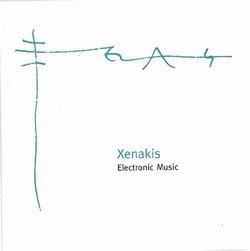Essential music of the 20th century.
gone daddy gone | 12/10/2002
(5 out of 5 stars)
"The late great Iannis Xenakis, if you don't know his work, was an absolute genius, mathematically, musically, he was even a great architect (studied under le Corbusier) and sadly a political refugee. The Electronic Music Foundation have performed a noble service by releasing this music (also for their Pierre Schaeffer box), although the title is somewhat misleading, this is actually ELECTRO ACOUSTIC MUSIC as opposed to electronic music, and though at this point in history (the earliest pieces are from the fifties) Electronic and electroacoustic music sounded very similar, this is rarely the case today. Beautiful, often ferocious, Atonal tape music. The closest thing to melody here is something that sounds like a metal plate amplified whist covered in thumbtacks being beaten by chains with a thousand glasses shattering and being filtered for ten minutes. Not for the weak minded, but essential for anyone who would understand experimental music."
Flawed sound quality
James M. Brody | Pennsylvania | 12/29/2005
(3 out of 5 stars)
"Each of these works is an essential work by Xenakis. Many of the earlier pieces appeared on LP. The problem with this recording is that everything subject to a limiter in the recording process. Rather than their being a balance between loud and soft, everything is loud and louder, and hence the incredible qualities of these groundbreaking works is lost in the horrible recorded sound. When I studied with the Xenakis at Indiana University, he was insistent on high quality sound and it is hard to believe that he could have approved the recordings on this release. Because of the importance of these works, I would love to see a remastering of this release."
A great collection with four top-notch works
R. Hutchinson | a world ruled by fossil fuels and fossil minds | 08/24/2005
(4 out of 5 stars)
"On the basis of the service provided by compiling these electronic works by Xenakis, the Electronic Music Foundation certainly deserves 5 stars. However in the interest of conveying the quality of the music, I give it only 4 stars because two of the six pieces are not up the quality of the other four.
The earliest four works were composed in the GRM studio (Groupe de Recherches Musicales), which was originally run by Pierre Schaeffer, electronic music pioneer and creator of the term "musique concrete." "Diomorphoses" (1957 -- 6'53") is a "a study of white noise and its graduations through the process of densification." "Concret PH" (1958 -- 2'42") was composed for the famous Philips Pavilion at the World Fair in Brussels, which Xenakis designed while working for Le Corbusier. "Concret PH" was played between two performances of Varese's "Poeme Electronique." It was created from a recording of crackling, burning embers, assembled in huge quantities and then varied in density. "Orient-Occident" (1960 -- 10'56") was composed as the soundtrack to a film commissioned by UNESCO about the development of humanity from prehistoric times to Alexander the Great. The piece contains more variety and dynamics than most of Xenakis's electronic works, to fascinating, compelling effect. Finally, "Bohor" (1962 -- 21'36") builds on the sound of chiming bells, and goes on far too long.
"Hibiki-Hana-Ma" (1970 -- 17'39") is the music for one of Xenakis's polytopes, a multi-media installation that was created for the Osaka World Fair. The title is Japanese for "reverberation-flower-interval"! One of Xenakis's finest electronic works, the piece uses instrumental source material exclusively, and the sound of an orchestra can be detected at intervals, variously altered. The last work included does not impress me in the slightest -- "S.709" (1992 -- 7'03"). It was composed using a new computer program Xenakis had created (GENDYN), but to my ears it is more crude and primitive sounding then the early works from GRM.
Look for the new remix of LA LEGENDE D'EER on Mode, Xenakis's 47' electronic work from 1978 (see my review). Mode is calling that release XENAKIS: ELECTRONIC WORKS 1, so we can look forward to more of this hard-to-find music..."


 Track Listings (6) - Disc #1
Track Listings (6) - Disc #1